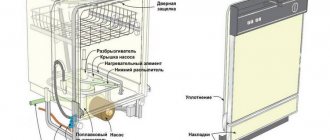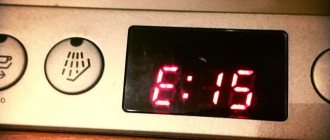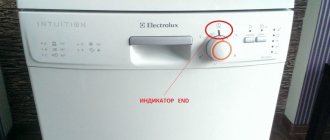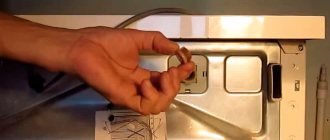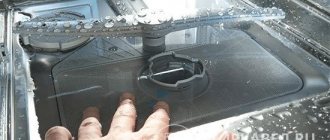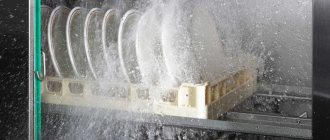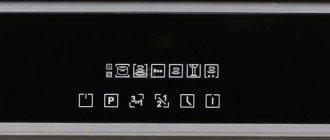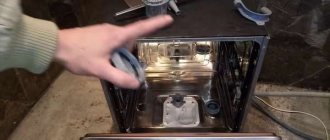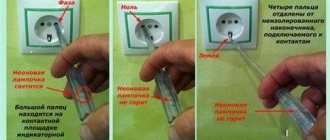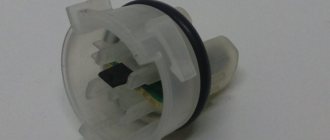4.9 / 5 ( 14 votes)
As usual, you put your dirty dishes in the dishwasher, turned them on and even selected a program, but the wash cycle did not start? In our article we will tell you what to do if the dishwasher does not work .
- Why won't my dishwasher turn on?
- Why is my dishwasher bad at washing dishes?
- Why does my dishwasher leak?
- How to fix the lock on a dishwasher?
Why won't my dishwasher turn on?
Why won't the dishwasher turn on?
The most common situations when the dishwasher refuses to turn on:
- The dishwasher starts, the sound of water is heard, but then the cycle stops. In this situation, the problem is the pump or heating element.
- The machine starts, the display lights up, but after “Switching on” nothing happens - no water flows, the washing does not start. The problem may be with the water supply valve or the dishwasher lock may be broken.
- After starting, the drain works, but the dishwasher buttons do not work. The machine's leak protection has turned on. You need to empty the water from the pan. Gently tilt the machine forward or wait until the water dries naturally. And then run the cycle again. If the problem is not solved by this, there is a leak inside the machine or at the pipes that go to it. The task is to find and fix the leak.
Please note that in the event of a breakdown, the dishwasher beeps, a code appears on the panel or the indication blinks, thereby informing about the reason why it is not working. If you see an error code on the panel, the instructions contain its meaning.
But if the display stops working, the machine does not react at all, you should try the following:
- Check electricity . Perhaps the outlet stopped working, the electricity in the house was cut off, or the plugs were knocked out.
- Make sure the plug and wire are intact . If there is damage, unplug the machine and call a technician.
If there are no problems on these two points, the reason why the dishwasher does not turn on is due to a breakdown.
Signs and causes of failure
The design of dishwashers from different brands is practically the same. Therefore, their problems are similar. Thus, PMM Bosch, Kuppersberg, Ariston may not start the sink or wash utensils poorly. And the latter is even worse. After all, water and electricity are wasted, and as a result you have to manually wash the plates.
Here are the main symptoms of the problem:
- The cycle does not start.
- The program started and ended. As a result, the devices remained dirty and did not even get wet.
- The machine draws and heats water, but does not wash dishes.
- The equipment takes on water and stops.
Why is this happening:
- Errors during operation.
- Problems with water supply, blockages.
- Lack of fluid circulation.
- The machine does not pick up detergent.
- Heating problems.
- Breakage of components and parts.
Let's start looking at problems in order of their complexity. At the initial stages, it is not difficult to detect and eliminate problems of poor washing at home. It is important to immediately monitor how the PMM performs the cycle in order to understand the cause of the problem.
Why is my dishwasher bad at washing dishes?
Why is my dishwasher bad at washing dishes?
At some point, you may open the machine and instead of clean plates you see dirty ones with food and detergent residue. The reasons may lie with you. That is, you are not using or caring for the dishwasher correctly. Or in breakdown. Let's figure it out.
The dishwasher may not work if you do not use it correctly:
- Load dishes with leftover food.
- Choose the wrong program. For example, a quick wash can only deal with light stains, but not with a greasy baking sheet.
- Reboot the machine. Try sending fewer dishes to the wash next cycle.
- You choose your detergents poorly. You can try changing the manufacturer or experimenting with the amount of rinse aid.
If poorly maintained, your car will develop:
- Scale . Appears due to poor water quality. And if scale is not noticeable on plastic, visible parts. Then the metal inside grows over it, the water flows in worse and worse and the dishes remain unwashed. Citric acid will help get rid of scale. You need to add it instead of detergent and run the dishwasher idle at the highest temperature.
- Blockages . This may be due to food, napkins and other debris that gets into the machine along with the dishes. Filters and sprinklers suffer from blockages, which also affects the quality of washing. Filters need to be cleaned and changed on time.
Poor care can also lead to the dishwasher not washing dishes well or breaking down.
Water circulation problems
The appliance has filled with water, but does not wash the dishes? It is important to understand how washing is carried out. The liquid is driven by a circulation pump through the heating element, after which it enters the spray nozzles. Through its nozzles, water flies under pressure into the chamber. By turning, the spray arms spray the liquid over the chamber and dishes.
Therefore, open the loading door and check the rocker arms. If their nozzles are clogged, then it’s clear why the equipment has stopped washing utensils. Remove the nozzles by pulling them towards you. Clean the holes with toothpicks and rinse with warm water.
If the PMM fills with water and does not work, the problem may be a problem with the circulation pump. You can replace the pump yourself, but it is better to entrust the inspection to a specialist. If the windings break, replacement is inevitable.
- Open access to the bottom.
- Remove the bottom panel.
- There is a pump in the center.
- Disable his contacts.
- Release the fastenings of the pipes and remove them.
- Replace the unit.
Why does my dishwasher leak?
The dishwasher is leaking
If you see a puddle in front of the dishwasher, before calling a technician and thinking that the door is broken, rule out other reasons:
- The door was opened during drying . When the dishes are on the dryer, steam comes out of the machine, it remains in drops on the edge and flows down the seal to the floor. There is no damage here. Do not open the dishwasher until drying has finished.
- The seal is not level . The chamber is depressurized. You need to level the machine.
- Wrong detergents . If you use bad detergents or add more than necessary, a lot of foam will form. There will be not only water with foam flakes near the machine. Don't use so much detergent and choose good manufacturers.
- Detergents have clogged the seal . When there is a lot of detergent, the residue settles in the seals. And a puddle appears on the floor. To remove excess detergent, you need to run the dishwasher on high temperature without dishes.
- Filters are clogged . The solution is to clean them on time.
Differences between dishwashers from different manufacturers
Troubleshooting any malfunction should be based on two things - an understanding of the general principles of operation of dishwashers and the design features of models of different brands.
For example, Bosch dishwashers have a heating element built into the pump , which complicates diagnostics and makes repairs more expensive. In the Hans PMM, the inlet valve is connected to the Aquastop system and is located on the inlet hose (its breakdown is a common cause of water intake, but lack of washing).
Its repair and replacement will be much more expensive than for models in which the valve is located in the machine body. Older models of any brand do not have a display on which you can see the error code, and you will have to find out what exactly is broken yourself.
The conclusion follows from this - you cannot start repairing your device without first studying the instructions, names and locations of parts.
Find out everything you need to know about dishwasher water in this section.
Does the list of factors change depending on the dishwasher model?
The list of reasons is the same for all brands and models of dishwashers because they work on the same principle.
Each manufacturer usually has its own:
- Bosch – E3/E8;
- Beko – 0000;
- Electrolux – i10, iA0;
- Indesit – Al02;
- Hansa, Samsung – E1;
- LG–IE.
The code only indicates the presence of a problem, not a specific malfunction. Therefore, in any case, inspection and diagnosis of the machine is necessary.
If the dishwasher does not work, proceed to consider individual faults:
Cable and socket problems
Don't discount power supply problems. Make sure that:
- The machine is plugged in.
- The power cord is not damaged.
- The fork is ok.
The cable itself rarely breaks. This happens when transporting or rearranging equipment. The cord can accidentally get crushed by furniture or the dishwasher itself. The copper strands inside are damaged and no electricity gets into the car. Insulation damage is also a serious reason for cable replacement. After a leak of the Beko, Gorenje, Hansa PMM, damaged wires can lead to a short circuit and fire.
Inspect the fork for signs of burning. If its body has melted, replacement is required. Check the condition of the outlet. Are there any visible burns on the outside? Connect another household appliance to it. If it does not work, a new outlet is installed.
Capacitor failure
This part is also called a line noise filter. During voltage surges in the network, it smoothes out interference. Therefore, a pure sinusoid is supplied to the parts, which prevents their combustion. When the filter takes a hit, it itself may suffer. Therefore, the first rule is a visual inspection of the part.
The condenser comes in conjunction with the circulation pump, so you will have to disassemble the housing a little.
- Remove the base panel.
- Depending on the model (Bosch, Electrolux, Indesit, Hansa), remove the fastenings of the side panels of the pallet.
- Turn the body on its side.
- Remove the pallet.
- There is a filter near the circulation pump.
- If swelling and burns are visible on the surface, remove the part and install a new one.
Also inspect the rest of the wiring. Damaged items must be repaired.
Damage to the start button or electronics
The button may become stuck if subjected to strong force when turned on. Contact with liquid detergents causes the keys to stick. Sometimes its contacts oxidize, so the module does not receive a signal to turn on. Check and replace the part.
Diagnosing a control module is not an easy task. The craftsmen use a multimeter and call all the triacs one by one. It is important to get the correct diagnosis in order to repair your electronics. Therefore, we recommend contacting a service center.
Prevention measures
In order to prevent a situation where half the program has passed and the washing suddenly stops, you need to remember several rules for operating the equipment:
- Place dishes cleaned of large food debris into the basket;
- Ensure the cleanliness of the coarse filter;
- Change the filling filter periodically;
- Wash the tank, blades and the entire machine from the inside;
- Clean the dishwasher from scale;
- Dry after each wash cycle.
In order to avoid problems with the operation of dishwashers, it is necessary to monitor their operation and carry out maintenance of the machine from time to time. This will take much less time than searching for the causes of the breakdown and its subsequent elimination.
What to do to fix the problem
You can fix problems in any brand of dishwasher (Ariston, Hansa, Beko) yourself. The main thing is to act consistently. Immediately check whether the camera door is locked properly.
Checking the Start button
Visually inspect the control panel. If the power key is stuck or detergent gets into the connectors, it will need cleaning and replacement. Disassemble the panel and check the button contacts with a multimeter. Replace the part if necessary.
Replacing the capacitor
As we wrote above, unstable voltage can ruin not only your nerves, but also your technique. Due to the sharp drop, the capacitor could burn out. It is necessary to check and replace the element:
- Remove the decorative bottom panel under the door.
- Remove the pallet mounting parts.
- Open the hopper door, unscrew the drain filter and pull out the spray arm.
- Place the dishwasher on the back wall.
- Unscrew the screws and remove the pan (at the same time disconnect the wiring, if any).
- Find the capacitor. The part is attached to the circulation pump.
- If no signs of scorch are visible externally, then check the element with a multimeter.
- Also inspect the wiring and make sure the contacts are working properly.
What are the problems with power cords?
The power cord itself, if you follow the rules of its operation, will not break. This is an ordinary cable and there is nothing to break in it. But if you are careless about its storage and transportation, and if the cord is not used for its intended purpose, then it may well deteriorate.
Most often, the power cord breaks when transporting the dishwasher.
Users will either weigh down the cord or use it as a securing device during transportation. As a result, the copper cores of the cord are damaged and the cord fails. In such cases, a more dangerous phenomenon may occur - overheating and burnout of the cord. This, in turn, can cause a fire.
If a problem is detected with the cable, it must be replaced. It cannot be repaired.
The integrity of the cable is checked by reading its actual resistance. A multimeter is used for this. If the resistance is high, the cable is rejected and sent as scrap.
Dishwasher condenser problems
Failure of a capacitor is associated with two reasons: poor-quality equipment and unstable power supply with surges in the network. The dishwasher condenser is located on the circulation pump and is not easy to get to. To do this, you need to remove one of the panels of the device body. The built-in equipment will have to be dismantled first.
The repair is quite complicated:
- disassembly of the device is necessary to get to the installation site of the capacitor;
- A special device will help determine the problem;
- broken capacitors cannot be repaired, they must be replaced;
- It’s not easy to choose the right components for your machine model;
- It is important to understand the cause of device failure in order to prevent future breakdowns.
When repairing dishwashers, it was noticed that capacitors last a long time and do not break without reason. The exception is inexpensive models, on which manufacturers saved money during production. In such technology, any device can fail at any time.
